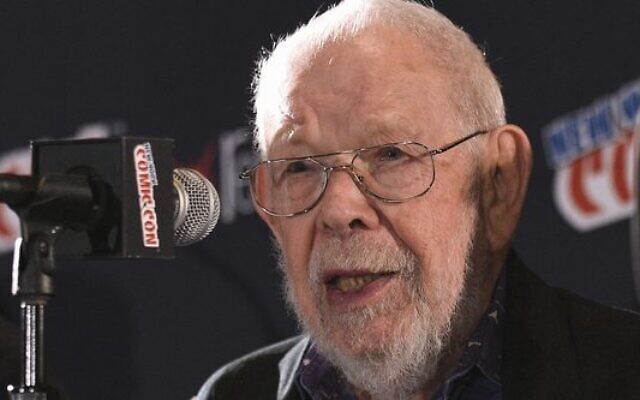Al Jaffee of Mad Magazine fame dies, aged 102
Al Jaffee died nine decades after returning from Lithuania and less than three years after the iconic cartoonist retired from Mad.

Perhaps the greatest influence on Al Jaffee, known to readers of Mad Magazine as the creator of the ‘Fold-In’, was the time he spent living in a Lithuanian shtetl as a child.
Jaffee was born in Savannah, Georgia, but returned to his mother’s native country with her after she became disillusioned by the irreligious character of life in America. Living in her small town, Zarasai, from ages 6 to 12, he became steeped in both the Yiddish and the “anti-adultism” that would infuse his work. He also gained fluency in comics through strips mailed by father, who remained in the United States.
Jaffee died last week in New York City, aged 102, nine decades after returning from Lithuania and less than three years after the iconic cartoonist retired from Mad, where he had inked the end-page feature since 1964.
The ‘Fold-In’ defined Mad Magazine ever since Jaffee invented it as a cartoon satire of the centrefold in publications like Playboy. The feature allowed readers to interact with the pages to form multiple images – the first one depicted Elizabeth Taylor’s divorce from Eddie Fisher and, after a fold, her subsequent marriage to Richard Burton.
A slew of comedians, especially baby boomers, credited Jaffee and his fellow Mad contributors – the self-described “usual gang of idiots” – with shaping their comic sensibilities.
I will always be grateful to the incredible Al Jaffee for taking my irreverence virginity…and all it took was one quick fold…#madmagazine
????RIP— Jon Stewart (@jonstewart) April 11, 2023
“RIP Al Jaffee. He had a profound influence on my mind when I was a kid. One of the greats,” the Jewish comedian and podcaster Marc Maron tweeted.
For a swathe of cartoon consumers – those associated with the Chabad-Lubavitch Jewish movement – Jaffee’s most important contribution came not in Mad’s pages but in a different publication, The Moshiach Times. There, Jaffee for decades inked a strip for children called The Shpy, depicting a rabbinic secret agent who battles the forces of evil. It was, he told a Chabad publication in 2020, shortly after his retirement at 99, a deeply personal endeavour.
“The Shpy wasn’t just some superhero. I couldn’t do that,” Jaffee said. “I had to draw a character I could get into.”
R.I.P. to the great Al Jaffee – I hope God doesn’t ask him any stupid questions. pic.twitter.com/iwB5rL5ZGZ
— Larry Karaszewski (@Karaszewski) April 10, 2023
Jaffee was born Abraham Jaffee on March 13, 1921 in Savannah, where his father, an immigrant from Lithuania, had been recruited from New York City to run a dry-goods shop. His mother, who had immigrated from the same town as his father, never took to life in the American south, where Orthodox Judaism was unfamiliar and kosher food hard to come by. When Jaffee, the oldest of four brothers, was 6, she bundled the children up and took them back to Lithuania for a visit that stretched for six years.
Jaffee’s biography characterises his time in Zarasai as one of both deprivation and invention, in which he was forced to come up with entertainment because there was little provided for the children. After Adolf Hitler’s rise to power in nearby Germany in 1933, his father retrieved him and two of his brothers, later sending for the third. Jaffee never saw his mother again after he returned to the United States; the Jews of Zarasai were executed by the Nazis and their Lithuanian collaborators on August 26, 1941.
Back in New York, Jaffee’s artistic prowess earned him a spot in the first class of the High School of Music and Art, where he connected with classmates who would be his partners for many years to come. He would create comics for several shops before settling in as a freelancer at Mad, where his high school friend Harvey Kurtzman was the editor and where Yiddish peppered the pages even as the humour magazine reached a wide audience. While Mad was recognisably Jewish to many Jewish readers, it did not proclaim itself as such – an approach that Jaffee told an interviewer in 2016 was intentional.
102 years old, and still gone much too soon. RIP to one of my all-time heroes, the great Al Jaffee. pic.twitter.com/hJ4XhcoCGl
— Al Yankovic (@alyankovic) April 10, 2023
“I lived through a period when Jewish people were very nervous about flaunting their Jewishness,” Jaffee said in the interview, published in the Forward, in which he explained that he still tended to think in Yiddish. “Even after the war, you were aware that there were people out there who wanted to kill you just because you were Jewish. And it’s still around.”
His side gig as the Chabad cartoonist began in 1984, after a young rabbi recruited him and other Mad contributors to add a contemporary aesthetic to a magazine with a circulation of about 10,000. Though Jaffee had a complicated relationship with Jewish observance, he signed on quickly, according to the Chabad feature about his tenure that was published in 2020.
In the story, Jaffee recalled highlights of his life in Zarasai, which had largely been described in negative terms in his earlier biography.
“My brother Harry and I would spend the whole year sketching and planning what we’d do to improve the design of lanterns,” Jaffee recalled about celebrating the holiday of Simchat Torah. “Then when the holiday came, we’d march around the bimah. It was so much fun.” He also said that he aspired to be like the Shpy, whose wispy beard resembled his own.
Jaffee announced his retirement in June 2020, months after the death of his wife of 42 years, Joyce Revenson. A previous marriage, to Ruth Ahlquist, with whom he had two children, ended in divorce. He is survived by his children, stepchildren, grandchildren and three great-grandchildren.
JTA

comments